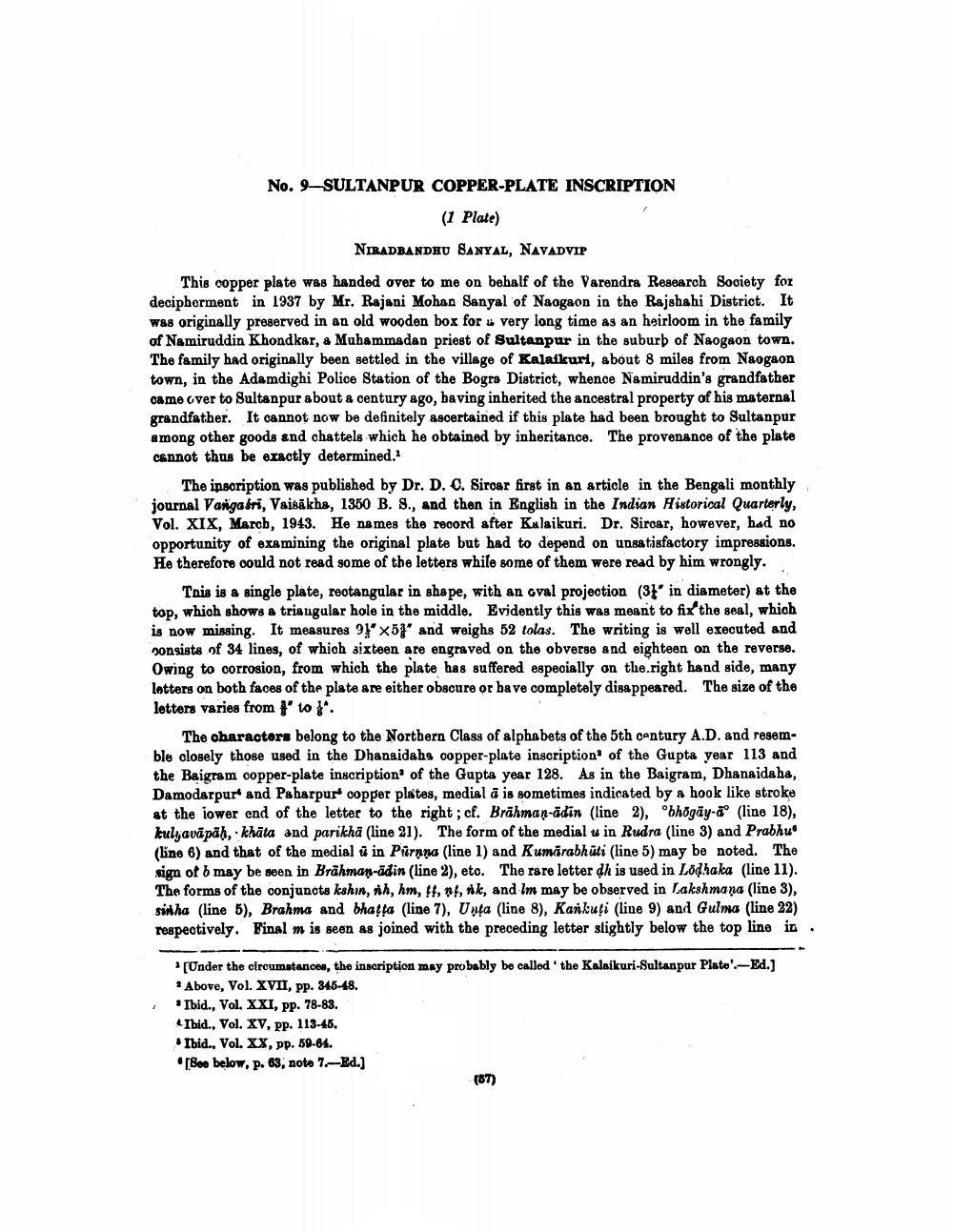________________
No. 9-SULTANPUR COPPER-PLATE INSCRIPTION
(1 Plate)
NIRADBANDHU SANYAL, NAVADVIP
This copper plate was handed over to me on behalf of the Varendra Research Society for decipherment in 1937 by Mr. Rajani Mohan Sanyal of Naogaon in the Rajshahi District. It was originally preserved in an old wooden box for very long time as an heirloom in the family of Namiruddin Khondkar, a Muhammadan priest of Sultanpur in the suburb of Naogaon town. The family had originally been settled in the village of Kalaikuri, about 8 miles from Naogaon town, in the Adamdighi Police Station of the Bogra District, whence Namiruddin's grandfather came over to Sultanpur about a century ago, having inherited the ancestral property of his maternal grandfather. It cannot now be definitely ascertained if this plate had been brought to Sultanpur among other goods and chattels which he obtained by inheritance. The provenance of the plate cannot thus be exactly determined.1
The inscription was published by Dr. D. C. Sircar first in an article in the Bengali monthly journal Vangasri, Vaisakha, 1350 B. S., and then in English in the Indian Historical Quarterly, Vol. XIX, March, 1943. He names the record after Kalaikuri. Dr. Sircar, however, had no opportunity of examining the original plate but had to depend on unsatisfactory impressions. He therefore could not read some of the letters while some of them were read by him wrongly.
This is a single plate, rectangular in shape, with an oval projection (31" in diameter) at the top, which shows a triangular hole in the middle. Evidently this was meant to fix the seal, which is now missing. It measures 9"x5" and weighs 52 tolas. The writing is well executed and consists of 34 lines, of which sixteen are engraved on the obverse and eighteen on the reverse. Owing to corrosion, from which the plate has suffered especially on the right hand side, many letters on both faces of the plate are either obscure or have completely disappeared. The size of the letters varies from " to ".
The characters belong to the Northern Class of alphabets of the 5th century A.D. and resemble closely those used in the Dhanaidahs copper-plate inscription of the Gupta year 113 and the Baigram copper-plate inscription of the Gupta year 128. As in the Baigram, Dhanaidaha, Damodarpur and Paharpur copper plates, medial a is sometimes indicated by a hook like stroke at the lower end of the letter to the right; cf. Brahman-adin (line 2), bhogay-a (line 18), kulyavapäḥ, khata and parikha (line 21). The form of the medial u in Rudra (line 3) and Prabhu (line 6) and that of the medial u in Purana (line 1) and Kumarabhuti (line 5) may be noted. The sign of b may be seen in Brahman-ädin (line 2), etc. The rare letter dh is used in Lödhaka (line 11). The forms of the conjuncts kshin, nh, hm, tt, nt, nk, and lm may be observed in Lakshmana (line 3), sinha (line 5), Brahma and bhatta (line 7), Unta (line 8), Kankuți (line 9) and Gulma (line 22) respectively. Final m is seen as joined with the preceding letter slightly below the top line in.
[Under the circumstances, the inscription may probably be called the Kalaikuri-Sultanpur Plate'.-Ed.] * Above, Vol. XVII, pp. 345-48.
Ibid., Vol. XXI, pp. 78-83.
Ibid., Vol. XV, pp. 113-45.
Ibid., Vol. XX, pp. 59-64. [See below, p. 63, note 7-Ed.]
(87)




